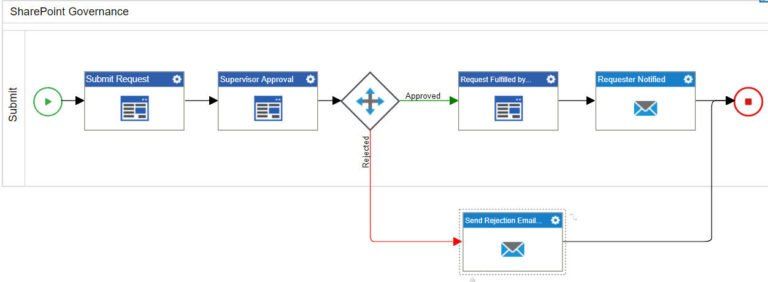(Watch the 8 minutes video at the end of the article to learn how to take RPA to a new height!)
In future humans would be evaluated on their ability to work with robots. Tremendous hunger to show efficiencies exist in organizations trying to outsmart their competition. With Robotic Process Automation (RPA) coming into prominence over last few years, a question which we come across sometimes is whether BPM and RPA compete with each other and if yes, does AgilePoint play any role in the RPA world? This is a topic that is frequently on the minds of business leaders.
While distinct in their own right, RPA and BPM are complementary to each other and, when deployed together, provide a powerful platform to enable digital transformation organization-wide. They are two solutions with the same common goal.
Later in this article, I have demonstrated in the video, how AgilePoint can work with RPA products like UIPath. But before we get into that, lets first look at the difference between RPA and BPM and then dive into how AgilePoint plays a role to bring both of them together.
What is Business Process Management (BPM)
For years, business process management (BPM) technologies have been a core part of many organizations’ digital transformation strategies. BPM is an approach to streamlining business processes for maximum efficiency and value. BPM is about making sure the infrastructure of your business processes is solid. It involves re-engineering of the underlying process to drive efficiency, eliminate bottlenecks, connect systems, increase productivity enterprise-wide and create a more consistent customer experience. BPM can have RPA as a solution as part of its tool set.
What is Robotic Process Automation (RPA)
Robotic Process Automation is a software technology that enables employees to better focus on high priority tasks by pushing routine, monotonous tasks to software “robots” to complete. Its primary focus is to replace manual labor and errors for tasks such as those that require emotional intelligence, reasoning and judgment – the ones that require a higher level of care and interaction with the customer. RPA is a surface level fix which does not replace the business process but makes it faster by replacing human effort. These robots work directly across application user interfaces, automatically inputting data and triggering actions across multiple systems acting on the behalf of an employee.
RPA is not always about screen scrapping. It has a lot more to it than just data entry which I will try to explain with an example below.
Example of BPM & RPA in Action: SharePoint Governance and Access request
SharePoint admins are involved with a number of highly important tasks some of which are repetitive, manual tasks that do not require complex decision making.
Below is a simplified version of an automated SharePoint governance process where an employee submits a request to be granted access to or be removed from a certain SharePoint site collection. After being approved by a supervisor, SharePoint admin can then review the request and complete the request as appropriate.

In this situation, the process has been automated with a BPM system, but still involves some manual work by SharePoint admin. Completing the request could involve logging into multiple site collections, opening up the appropriate pages to grant access rights, applying the appropriate settings, logging out of the applications, and marking the request as completed.
As an individual request, performing these tasks may not take a significant amount of time, but if it is happening multiple times a day, it can distract from other valuable actions that a skilled SharePoint admin professional will need to complete.
While SharePoint admin may want to closely monitor the requests to see who is gaining access to what, the actual actions involved with granting access may not be as important. Adding an RPA bot to perform the manual tasks that will likely need to be repeated multiple times as employees change roles, join the organization, etc., will further optimize the overall process flow and free up the admin to focus time on other priority work. It benefits the organization to have SharePoint professionals focus their energy on tasks that actually require human decision-making and nuanced consideration.
RPA technology helps fill in these types of gaps in a BPM process, allowing organizations to achieve an even higher level of efficiency that may not have been as possible before. Existing systems remain in place, where bots would perform the monotonous actions a person would typically need to perform. Once the bot has completed its task, BPM can take over, pushing follow-up actions and results to the employee to complete or review. Offloading time-consuming, repetitive tasks to bots as part of a BPM solution will help enable employees better focus their talents on more productive work only they can do.
The AgilePoint Story
A lot of you in past have come to know of AgilePoint as a key Business Process Management (BPM) player in the market for over a decade. However back in 2015, when AgilePoint NX was released, it quickly evolved into a low-code high productivity platform as a service (hpaPaaS) solution, which enables application designers to create both process and data-centric applications while still maintaining some of the key strengths of the BPM to provide its users the best of both worlds.
The way I see it is that most traditional BPM products were pretty strong on streamlining process efficiencies but still depended largely on humans to carry out the work albeit in a controlled manner. This largely was due to fact that though traditional BPM players had invested in integrations and automation but it was not enough to meet industry needs as most organizations have multiple systems and API’s for these systems are not the same and evolve over the time resulting broken integration and hence tasks were being assigned to humans to make sure data is entered in these external systems. This is where AgilePoint NX started growing out of its BPM avatar into more of a Low code platform with strong focus on integrations with more than 60+ external systems on both process as well as form level to automate entering data in the external systems without needing human intervention or even driving business process outcomes based on data that existed in external systems hence reducing somewhat the need to complement it with a RPA system.
A couple of years back, we at AgilePoint decided to embrace the trend and started investing heavily in technologies such as Bots, AI, Natural Language Processing, Machine Learning based process execution, Cognitive Services, RPA etc. which have been covered in some of my previous blog post in great depth.
For e.g. in the following blog post I demonstrated, how a partner invoicing can be automated with SharePoint and Salesforce by having bot and business process working side by side in a secured and efficient way.
Similarly there have been few more use cases shown on Bot in the blog where some of the bots work with Azure machine learning and NLP engine to help offload a lot of mundane data entry and decision making work from the information worker.
However there are still going to be use cases where automation has to be achieved in existing applications which do not have any API and mainly would depend on things like screen scrapping and keystroke based learning. This is where RPA tools will be a great fit. Great thing about the AgilePoint integration approach is that it is easily able to integrate with third party RPA tools as well to trigger this automation.
Here is a demo which I recorded with a famous RPA product called UIPath.
RPA typically is known to work with structured data only but with AgilePoint’s investment in AI, NLP, cognitive services and more importantly process driven app approach, it helps RPA extract structure out of unstructured data using text analytics and AI. The combination of these technologies within AgilePoint also helps in ingesting an Omni-Channel experience to understand customer scenario better and automate it to best possible extent.
Although BPM and RPA technologies can be deployed separately in digital transformation initiatives, it is when they are strategically implemented together that their individual benefits are compounded. BPM and RPA complement each other, forming a powerful duo that can help organizations further deliver on their process automation goals. In the future, RPA will become even more of an incorporated part of traditional BPM systems and organizations’ overall digital transformation toolkit.
With AgilePoint, RPA + Low Code + BPM, provides organizations all above mentioned advantages to achieve a true business process automation platform.
Are you ready to reengineer your business
automation processes?

A modern process automation and orchestration platform that enables you to open up and seize new business opportunities, supercharge innovation, unlock new levels of efficiency and productivity, and deliver the experiences that help you win.
Follow Us
Platform

Automate business processes and workflows at scale. AgilePoint helps enterprises democratize and accelerate digital transformation, reduce technical debt and future-proof ROI.
Resources
© 2023 AgilePoint. All rights reserved.



